Structural Optimization of Jet Fish Pump Design Based on a Multi-Objective Genetic Algorithm
Abstract
:1. Introduction
2. Materials and Methods
2.1. Jet Fish Pump
2.2. Description of the Optimization Problem
- Optimization variable: T = (α, m, L/Dt)
- Optimization object: Maximize {−∇pr, η}, Maximize {−e, η}.
2.3. Experimental Design
2.3.1. Uniform Experimental Design
- Suction chamber inclination angle α: from 19° to 42.2°;
- Area ratio m: from 1 to 4.625;
- Throat length-diameter ratio L/Dt: from 2 to 4.03.
2.3.2. Sample Space Solution
2.4. Neural Network Design
2.4.1. Normalization of Sample Data
2.4.2. Determination of the Number of Hidden Nodes
2.4.3. Comparison of BP Neural Network Construction
2.5. NSGA-II Genetic Algorithm Verification
3. Results and Discussion
3.1. Basic Analysis of Optimization Results
3.2. Analysis of Internal Flow Field before and after Optimization
4. Conclusions and Future Direction
- (1)
- By comparing with Pareto solution sets, the reality of the NSGA-II multi-objective genetic algorithm is verified. This multi-objective genetic algorithm can optimize η and ∇pr as well as η and e of the internal structural parameters of the jet fish pump. The obtained ∇pr-η Pareto frontier and e-η Pareto front can reflect the excellent ability of the NSGA-II multi-objective genetic algorithm to search for Pareto non-dominated solutions.
- (2)
- According to optimization results, efficiency, radial pressure gradient and exposure strain rate cannot be optimal at the same time. The optimized structural parameters considering ∇pr-η are different from those considering e-η.
- (3)
- Aiming at high jet pump efficiency and low radial pressure gradient, the optimized structure combination is that m = 2.1, α = 20°and L/Dt = 2.2. The radial pressure gradient in the jet fish pump with this structure combination can be decreased to about 40% of that in the origin jet fish pump before optimization.
- (4)
- Aiming at high jet pump efficiency and low exposure strain rate, the optimized structure combination is that m = 1.5, α = 19.15° and L/Dt = 2.5. The exposure strain rate and dangerous area scope in the jet fish pump with this structure combination can be decreased at about 12.5% and 50% of that in the origin jet fish pump before optimization, respectively. In addition, the efficiency of this jet fish pump with optimized structure is increased by 4.8%.
- (1)
- The motion of fish could affect the distribution of the flow field, which was ignored in this research. For further study, researchers could pay more attention to the swimming of fish and achieve a more optimized model of a jet fish pump.
- (2)
- Limited by computing resources, input samples of structural parameters are relatively few. For additional research, it is necessary to expand the range of structural parameters and increase the level of input variables to obtain a more accurate internal mapping relationship.
- (3)
- In the present research, two objectives of ∇pr-η and e-η were optimized by the NSGA-II genetic algorithm, respectively. For the following research, multi-objective optimization combining η with ∇pr and e could be carried out and provide a theoretical basis for high-efficiency and low fish-loss jet fish pump design.
Author Contributions
Funding
Data Availability Statement
Conflicts of Interest
References
- FAO. The State of World Fisheries and Aquaculture 2020; FAO: Rome, Italy, 2020. [Google Scholar]
- Long, X.; Xu, M.; Qiao, L.; Zou, J. Impact of the internal flow in a jet fish pump on the fish. Ocean Eng. 2016, 126, 313–320. [Google Scholar] [CrossRef]
- Xiao, L.; Long, X.; Li, L.; Xu, M.; Wu, N.; Wang, Q. Movement characteristics of fish in a jet fish pump. Ocean Eng. 2015, 108, 480–492. [Google Scholar] [CrossRef]
- Long, X.; Xu, M.; Wang, J.; Zou, J.; Ji, B. An experimental study of cavitation damage on tissue of Carassius auratus in a jet fish pump. Ocean Eng. 2019, 174, 43–50. [Google Scholar] [CrossRef]
- Moses, D.; Colt, J. Impact of fish feed on airlift pumps in aquaculture systems. Aquacult. Eng. 2018, 80, 22–27. [Google Scholar] [CrossRef]
- Xu, M.; Ji, B.; Zou, J.; Long, X. Experimental investigation on the transport of different fish species in a jet fish pump. Aquacult Eng. 2017, 79, 42–48. [Google Scholar] [CrossRef]
- Huang, X.; Guo, G.; Tao, Q. Research on key technology and design for jet fish pump. SCFS 2007, 3, 41–46. (In Chinese) [Google Scholar]
- Wu, N.; Li, L.; Hou, J.; Long, X.; Xu, M.; Su, Y.; Lin, W. Stress reponse of grass carp after passing the jet fish pump. J. Huazhong Agricult. Univ. 2016, 35, 75–83. (In Chinese) [Google Scholar]
- Xu, M.; Long, X.; Mou, J.; Ji, B.; Ren, Y. Impact of fish locomotion on the internal flow in a jet fish pump. Ocean Eng. 2019, 187, 106227. [Google Scholar] [CrossRef]
- Neitzel, D.A.; Richmond, M.C.; Dauble, D.D.; Mueller, R.P.; Moursund, R.A.; Abernethy, C.S.; Guensch, G.R. Laboratory Studies on the Effects of Shear on Fish; Pacific Northwest National Laboratory: Richland, WA, USA, 2000.
- Neitzel, D.A.; Dauble, D.D.; Čada, G.F.; Richmond, M.C.; Guensch, G.R.; Mueller, R.P.; Amidan, B. Survival estimates for juvenile fish subjected to a laboratory-generated shear environment. Trans. Am. Fish. Soc. 2004, 133, 447–454. [Google Scholar] [CrossRef]
- Guensch, G.R.; Mueller, R.P.; McKinstry, C.A.; Dauble, D.D. Evaluation of Fish-Injury Mechanisms during Exposure to a High-Velocity Jet; Pacific Northwest National Laboratory: Richland, WA, USA, 2003.
- Pribyl, A.L.; Kent, M.L.; Parker, S.J.; Schreck, C.B. The response to forced decompression in six species of pacific rockfish. Trans. Am. Fish. Soc. 2011, 140, 374–383. [Google Scholar] [CrossRef]
- Hannah, R.W.; Parker, S.J.; Matteson, K.M. Escaping the surface: The effect of capture depth on submergence success of surface-released Pacific rockfish. N. Am. J. Fish Manag. 2008, 28, 694–700. [Google Scholar] [CrossRef]
- Hannah, R.W.; Rankin, P.S.; Penny, A.N.; Parker, S.J. Physical model of the development of external signs of barotrauma in Pacific rockfish. Aquat. Biol. 2008, 3, 291–296. [Google Scholar] [CrossRef]
- Xu, M.; Long, X.; Mou, J.; Wu, D.; Zhou, P.; Gu, Y. Impact of pressure gradients on fish scales in a jet fish pump. Biosyst. Eng. 2020, 191, 27–34. [Google Scholar] [CrossRef]
- Xu, M.; Mou, J.; Wu, D.; Zhou, P.; Gu, Y.; Zheng, S. Probability evaluation of hydrodynamic shear damage for fish passing through jet fish pumps. Int. J. Fluid Mach. Syst. 2020, 13, 536–542. [Google Scholar] [CrossRef]
- Wong, B.K.; Lai, V.S.; Lam, J. A bibliography of neural network business applications research: 1994–1998. Comput. Oper. Res. 2000, 27, 1045–1076. [Google Scholar] [CrossRef]
- He, C.; Gu, Y.; Zhang, J.; Ma, L.; Yan, M.; Mou, J.; Ren, Y. Preparation and modification technology analysis of ionic Polymer-Metal Composites (IPMCs). Int. J. Mol. Sci. 2022, 23, 3522. [Google Scholar] [CrossRef]
- Zhou, Y.; Cao, S.; Kosonen, R.; Hamdy, M. Multi-objective optimisation of an interactive buildings-vehicles energy sharing network with high energy flexibility using the Pareto archive NSGA-II algorithm. Energy Convers. Manag. 2020, 218, 113017. [Google Scholar] [CrossRef]
- Luo, H.; Zhou, P.; Shu, L.; Mou, J.; Zheng, H.; Jiang, C.; Wang, Y. Energy performance curves prediction of centrifugal pumps based on constrained PSO-SVR model. Energies 2022, 15, 3309. [Google Scholar] [CrossRef]
- Yang, D.; Zhou, X.; Yang, Z.; Jiang, Q.; Feng, W. Multi-objective optimization model for flexible job shop scheduling problem considering transportation constraints: A comparative study. In Proceedings of the 2020 IEEE Congress on Evolutionary Computation (CEC), Glasgow, UK, 19 July 2020; pp. 1–8. [Google Scholar]
- Elger, D.F.; Taylor, S.J.; Liou, C.P. Recirculation in an annular-type jet pump. J. Fluid Eng. T ASME 1994, 116, 735–740. [Google Scholar] [CrossRef]
- Yang, X.; Long, X.; Kang, Y.; Xiao, L. Application of constant rate of velocity or pressure change method to improve annular jet pump performance. Int. J. Fluid Mach. Syst. 2013, 6, 137–143. [Google Scholar] [CrossRef] [Green Version]
- Xiao, L.; Long, X.; Lyu, Q.; Hu, Y.; Wang, Q. Numerical investigation on the cavitating flow in annular jet pump under different flow rate ratio. In IOP Conference Series: Earth and Environmental Science; IOP Publishing: Bristol, UK, 2014; p. 052001. [Google Scholar]
- Fang, K.; Liu, M.-Q.; Qin, H.; Zhou, Y. Theory and Application of Uniform Experimental Designs; Springer: Berlin/Heidelberg, Germany, 2018; p. 221. [Google Scholar]
- Qi, S.; Jin, K.; Li, B.; Qian, Y. The exploration of internet finance by using neural network. J. Comput. Appl. Math. 2020, 369, 112630. [Google Scholar] [CrossRef]
- Chang, L.; Xu, X.; Liu, Z.; Qian, B.; Xu, X.; Chen, Y. BRB prediction with customized attributes weights and tradeoff analysis for concurrent fault diagnosis. IEEE Syst. J. 2020, 15, 1179–1190. [Google Scholar] [CrossRef]
- Liu, J.; Chen, X. An improved NSGA-II algorithm based on crowding distance elimination strategy. Int. J. Comput. Int. Sys. 2019, 12, 513. [Google Scholar] [CrossRef] [Green Version]
- Gao, X.; Chen, B.; He, X.; Qiu, T.; Li, J.; Wang, C.; Zhang, L. Multi-objective optimization for the periodic operation of the naphtha pyrolysis process using a new parallel hybrid algorithm combining NSGA-II with SQP. Comput. Chem. Eng. 2008, 32, 2801–2811. [Google Scholar] [CrossRef]

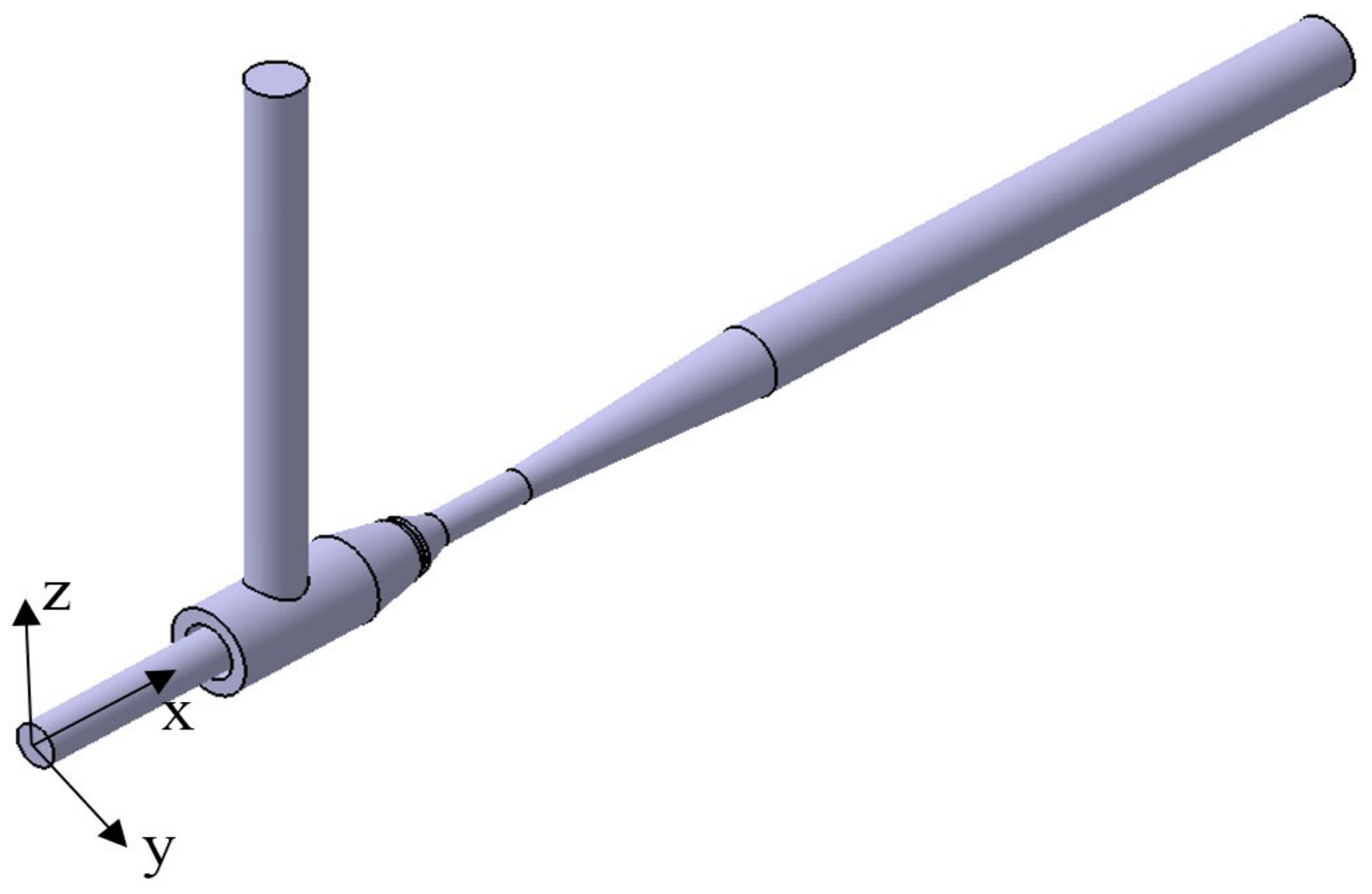
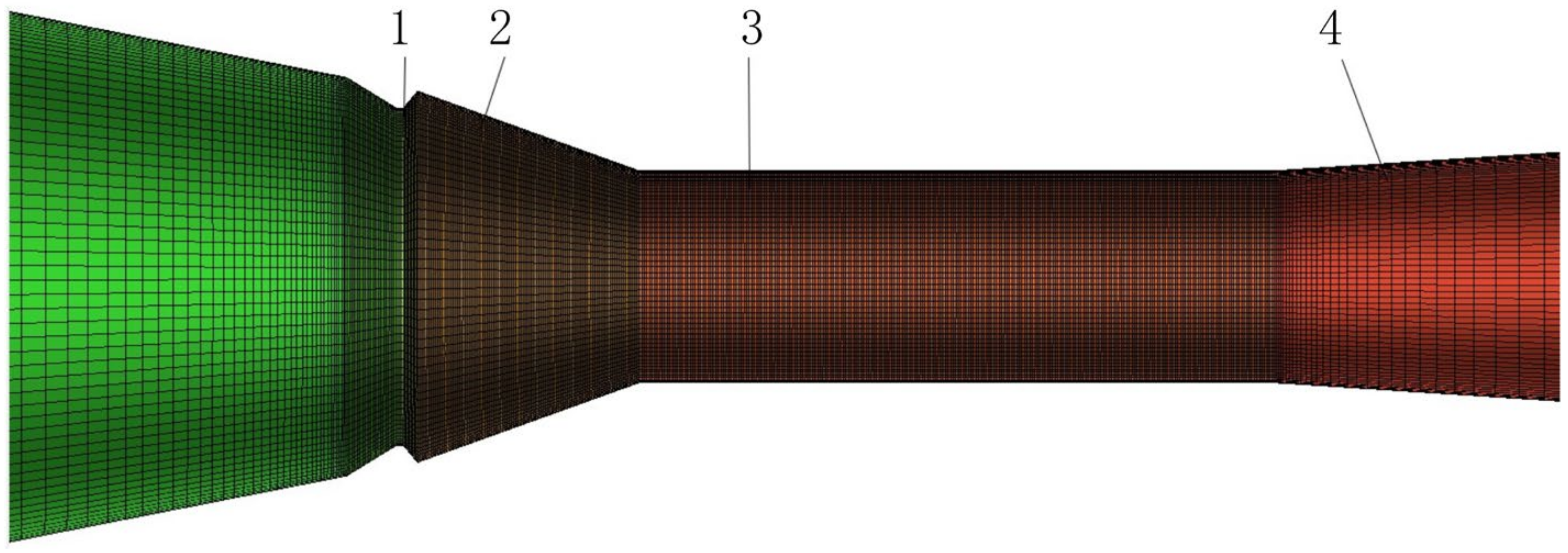

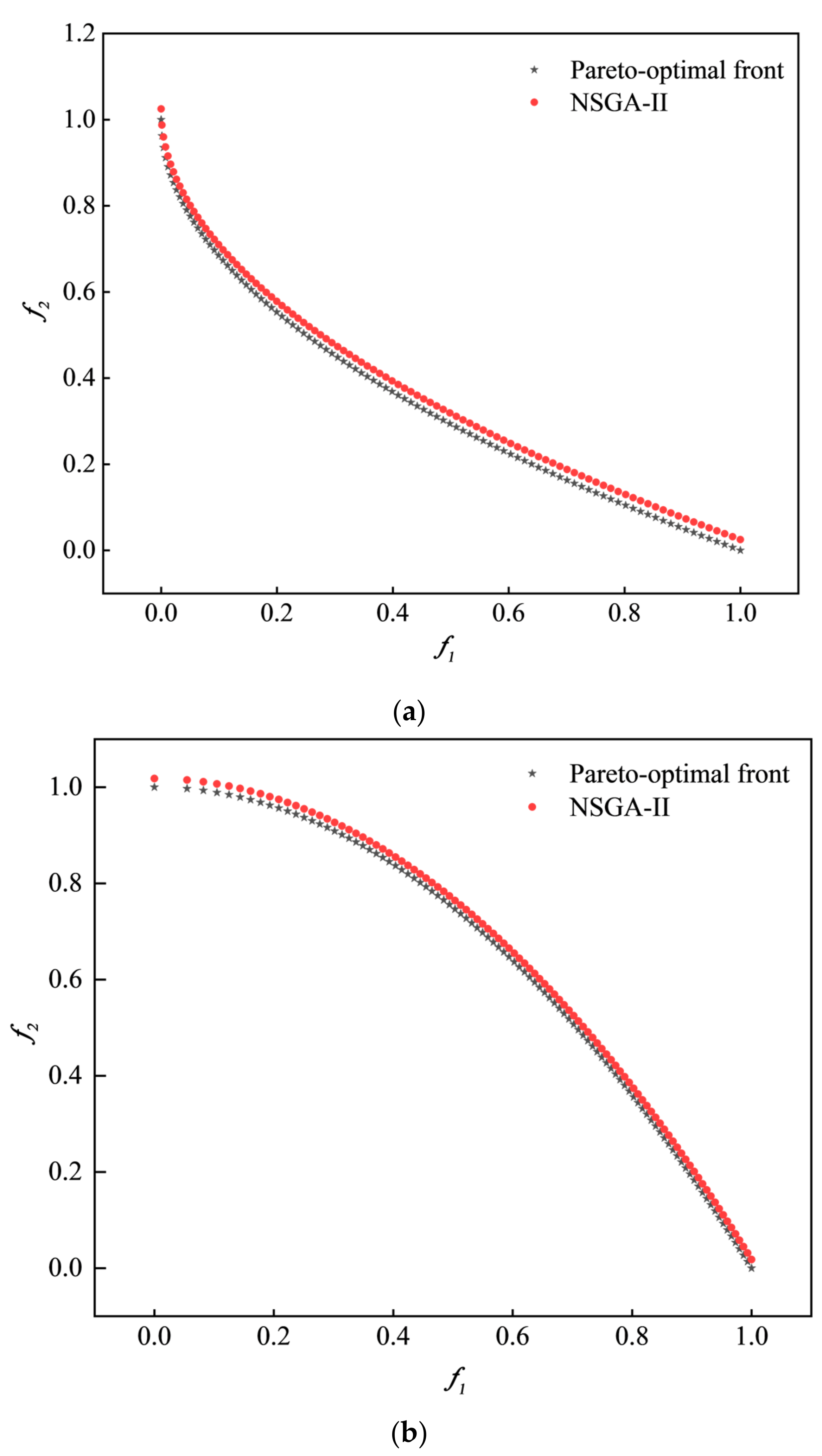
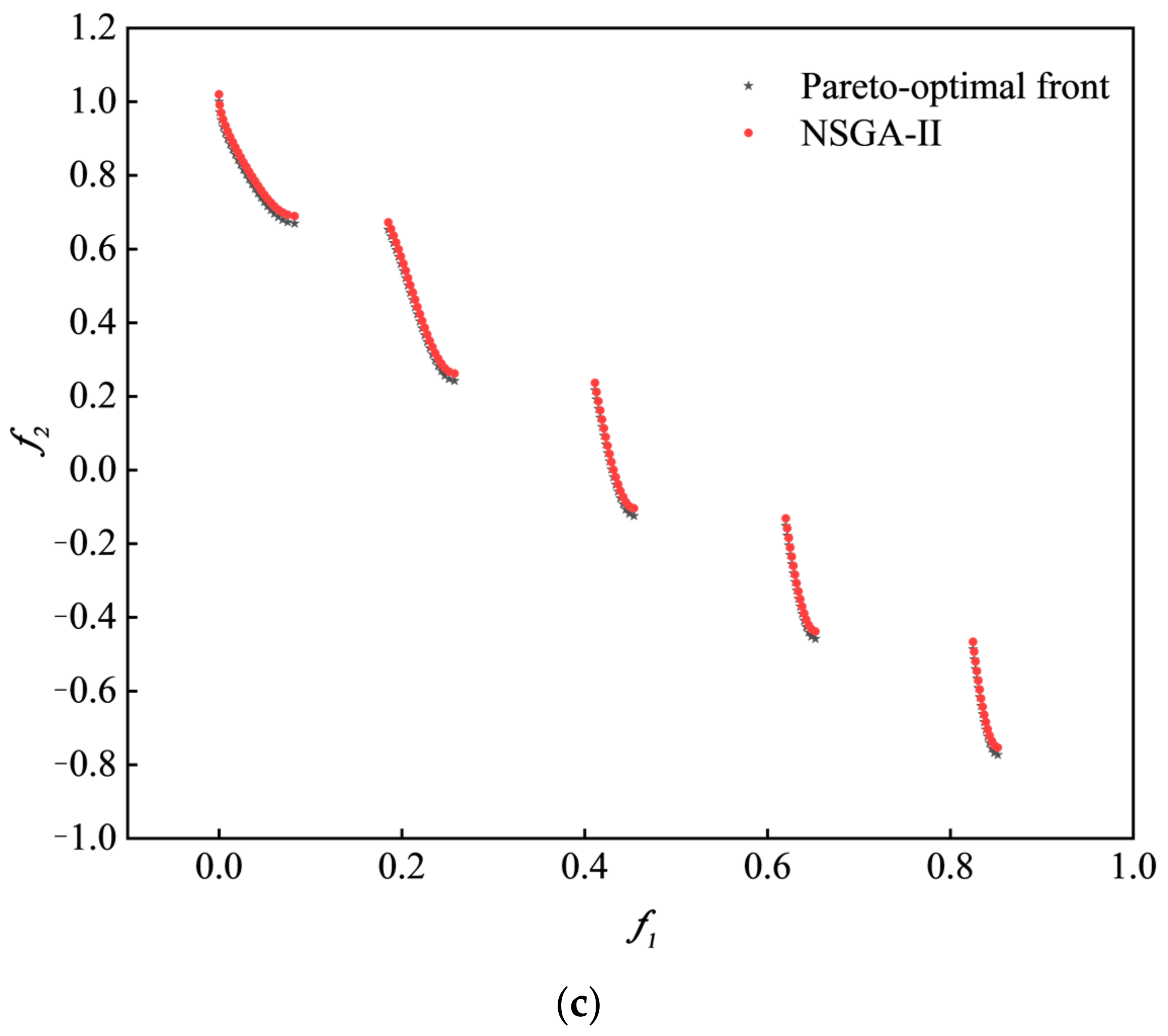
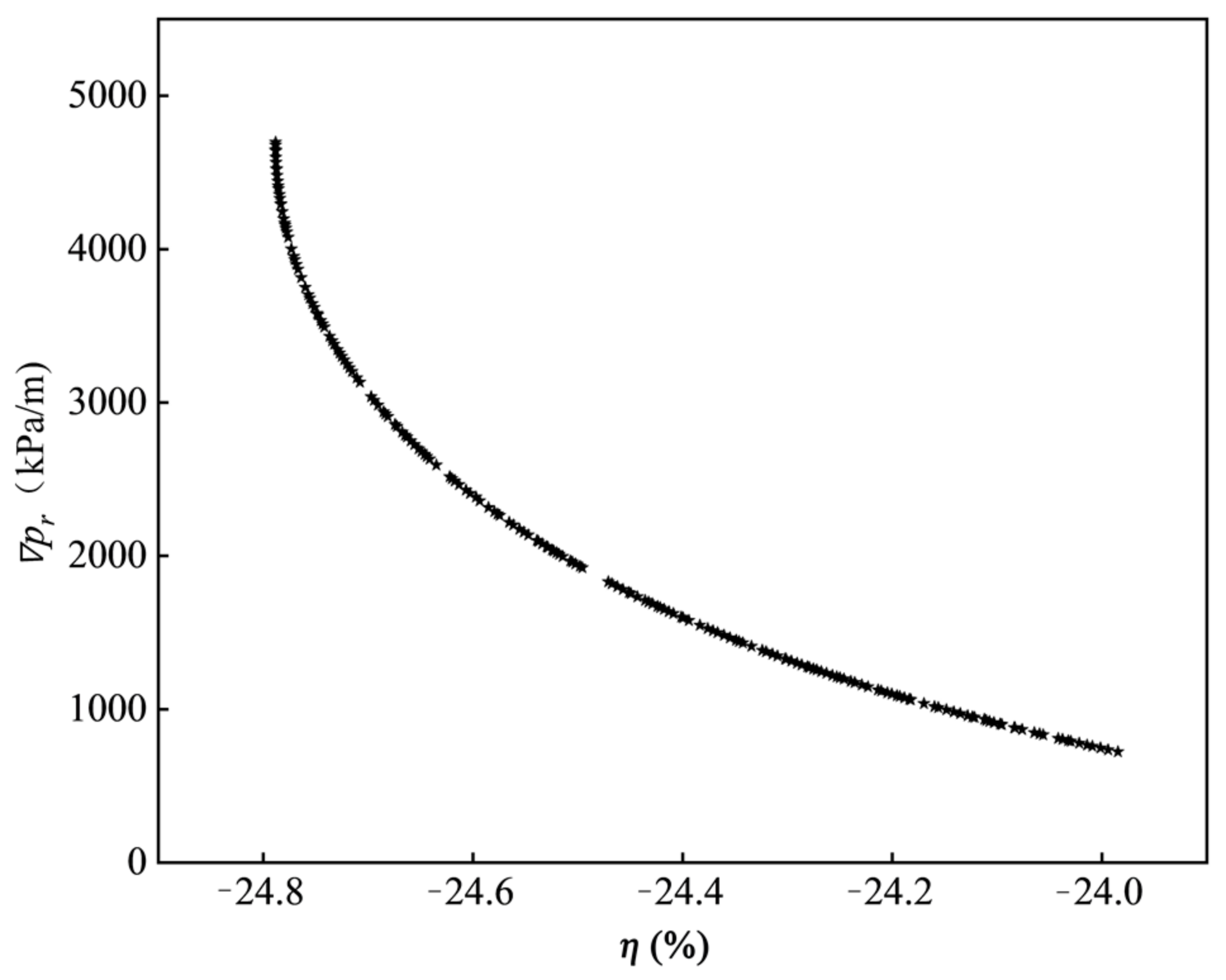

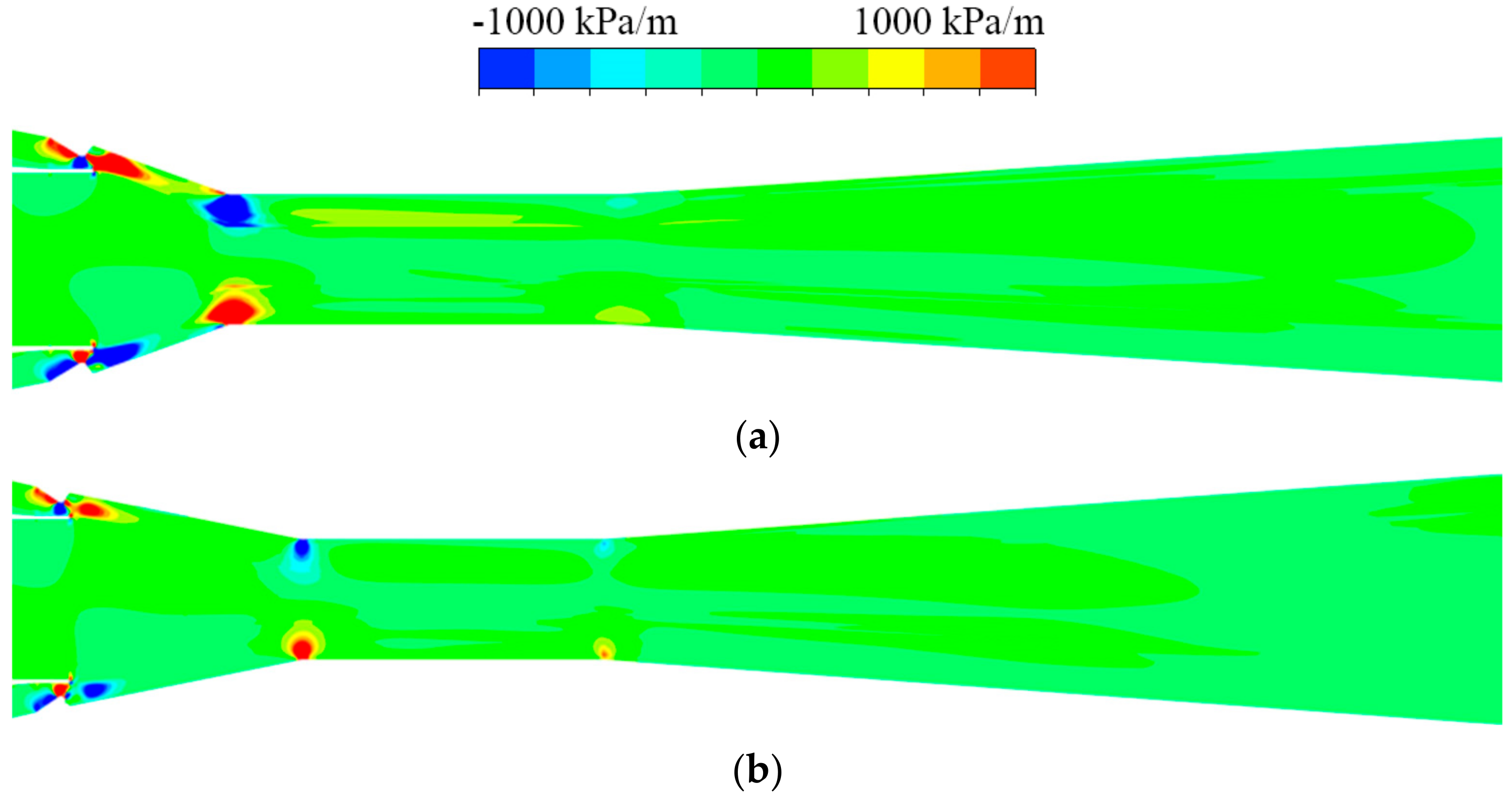
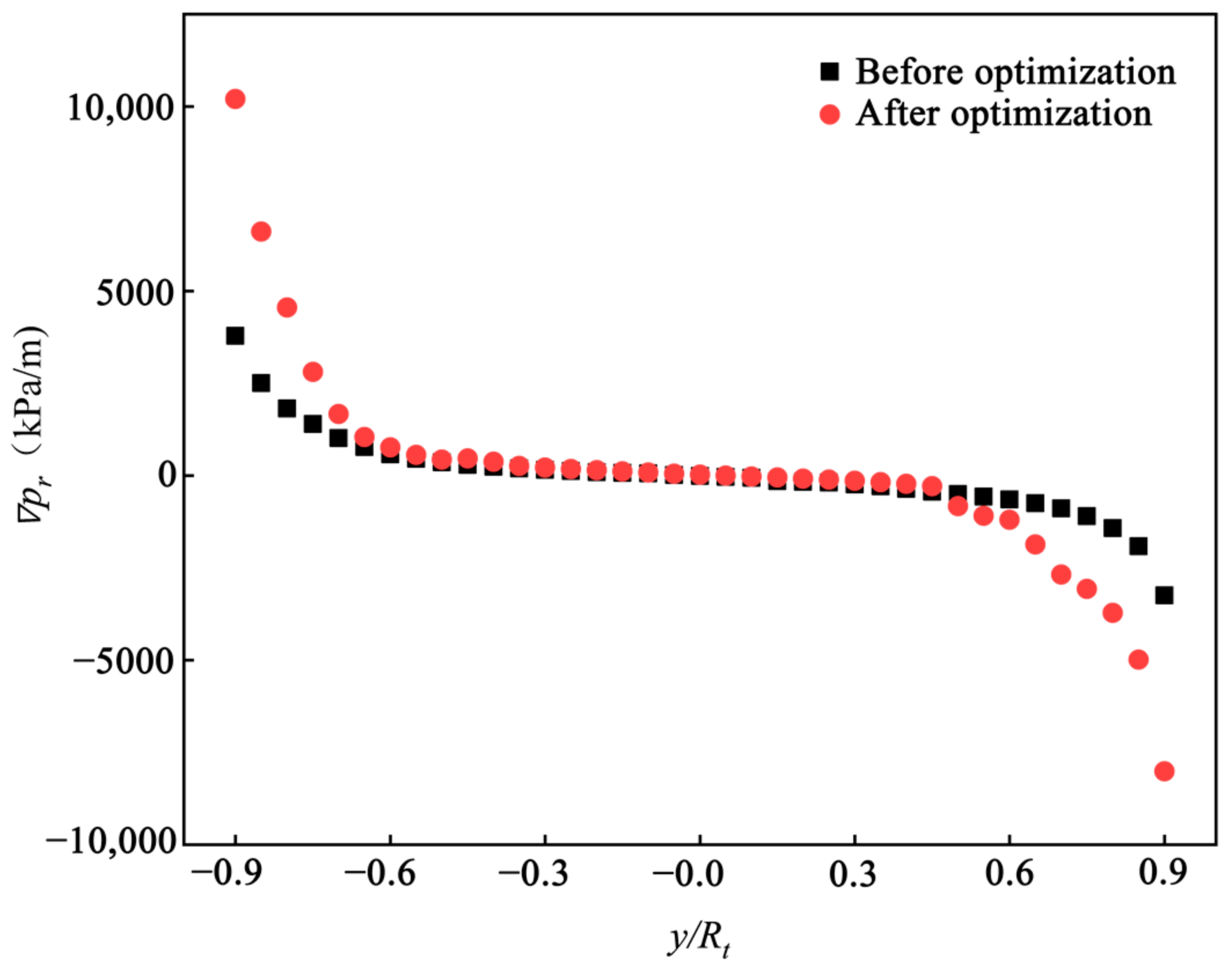
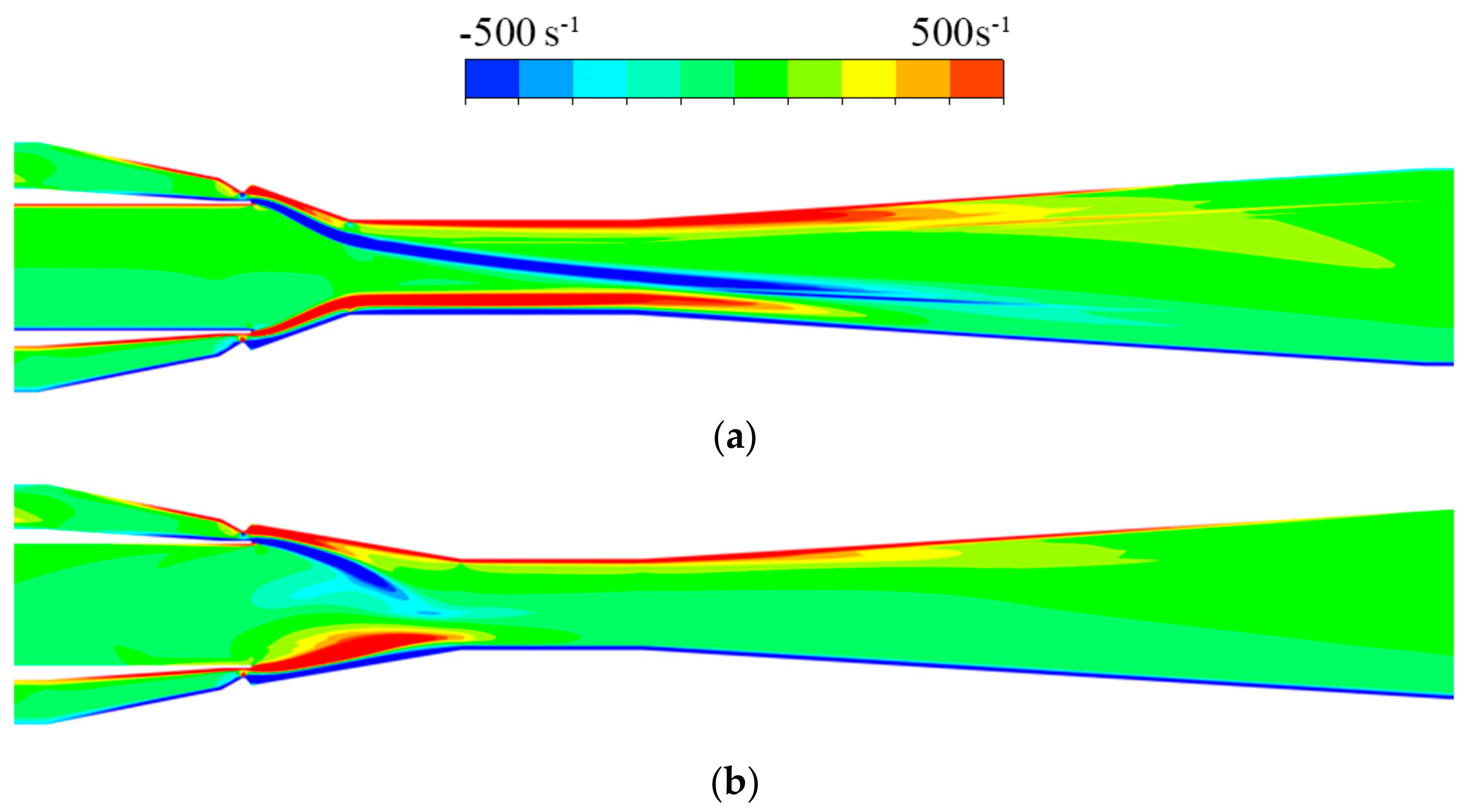
| Parameter | Ds(mm) | Dp(mm) | Dt(mm) | Dd(mm) | α(°) | β(°) |
|---|---|---|---|---|---|---|
| Size | 80 | 100 | 60 | 125 | 39 | 7 |
| NO. | α/(°) | m | L/Dt | ∇pr/(kPa/m) | e/(s−1) | η/(%) |
|---|---|---|---|---|---|---|
| 1 | 19 | 3.25 | 3.47 | 5340 | 942.545 | 16.99 |
| 2 | 19.8 | 1.75 | 2.84 | 28,115 | 914.349 | 18.75 |
| 3 | 20.6 | 4.125 | 2.21 | 5410 | 987.528 | 16.90 |
| 4 | 21.4 | 2.625 | 3.75 | 5570 | 998.607 | 16.92 |
| 5 | 22.2 | 1.125 | 3.12 | 5890 | 1097.280 | 18.41 |
| 6 | 23 | 3.5 | 2.49 | 9133 | 1358.620 | 16.66 |
| 7 | 23.8 | 2 | 4.03 | 5187 | 1002.740 | 19.24 |
| 8 | 24.6 | 4.375 | 3.4 | 12,900 | 1815.040 | 14.41 |
| 9 | 25.4 | 2.875 | 2.77 | 8285 | 1512.280 | 19.35 |
| 10 | 26.2 | 1.375 | 2.14 | 6086 | 965.498 | 16.81 |
| 11 | 27 | 3.75 | 3.68 | 13,662 | 1892.400 | 15.59 |
| 12 | 27.8 | 2.25 | 3.05 | 5682 | 1301.140 | 22.12 |
| 13 | 28.6 | 4.625 | 2.42 | 18,477 | 2289.660 | 13.02 |
| 14 | 29.4 | 3.125 | 3.96 | 11,287 | 1707.770 | 18.19 |
| 15 | 30.2 | 1.625 | 3.33 | 5734 | 1076.140 | 20.76 |
| 16 | 31 | 4 | 3.89 | 15,765 | 1085.120 | 34.57 |
| 17 | 31.8 | 2.5 | 3.47 | 8896 | 1663.190 | 21.87 |
| 18 | 32.6 | 1 | 3.61 | 4614 | 432.414 | 1.85 |
| 19 | 33.4 | 3.375 | 2.98 | 16,500 | 1950.460 | 17.21 |
| 20 | 34.2 | 1.875 | 2.35 | 6558 | 1521.680 | 23.88 |
| 21 | 35 | 4.25 | 2.07 | 23,944 | 2276.480 | 13.52 |
| 22 | 35.8 | 2.75 | 3.26 | 13,059 | 2063.720 | 21.08 |
| 23 | 36.6 | 1.25 | 2.125 | 5695 | 1081.482 | 18.30 |
| 24 | 37.4 | 3.625 | 2 | 20,666 | 2201.540 | 16.31 |
| 25 | 38.2 | 2.125 | 3.54 | 19,313 | 1875.480 | 23.56 |
| 26 | 39 | 4.5 | 2.91 | 28,279 | 2403.170 | 13.13 |
| 27 | 39.8 | 3 | 2.28 | 17,716 | 2069.190 | 19.39 |
| 28 | 40.6 | 1.5 | 3.82 | 7379 | 1098.200 | 17.40 |
| 29 | 41.4 | 3.875 | 3.19 | 27,138 | 2437.370 | 15.14 |
| 30 | 42.2 | 2.375 | 2.56 | 13,437 | 2015.680 | 23.61 |
| NO. | α/(°) | m | L/Dt | ∇pr/(kPa/m) | e/(s−1) | η/(%) |
|---|---|---|---|---|---|---|
| 1 | 0.0000 | 0.6207 | 0.7241 | 0.0965 | 0.0965 | 0.4627 |
| 2 | 0.0345 | 0.2069 | 0.4138 | 0.9935 | 0.9935 | 0.5165 |
| 3 | 0.0690 | 0.8621 | 0.1034 | 0.0993 | 0.0993 | 0.4600 |
| 4 | 0.1034 | 0.4483 | 0.8621 | 0.1056 | 0.1056 | 0.4606 |
| 5 | 0.1379 | 0.0345 | 0.5517 | 0.0000 | 0.0000 | 0.5061 |
| 6 | 0.1724 | 0.6897 | 0.2414 | 0.2459 | 0.2459 | 0.4526 |
| 7 | 0.2069 | 0.2759 | 1.0000 | 0.0511 | 0.0511 | 0.5315 |
| 8 | 0.2414 | 0.9310 | 0.6897 | 0.3943 | 0.3943 | 0.3839 |
| 9 | 0.2759 | 0.5172 | 0.3793 | 0.2125 | 0.2125 | 0.5348 |
| 10 | 0.3103 | 0.1034 | 0.0690 | 0.0471 | 0.0471 | 0.4572 |
| 11 | 0.3448 | 0.7586 | 0.8276 | 0.4243 | 0.4243 | 0.4199 |
| 12 | 0.3793 | 0.3448 | 0.5172 | 0.1100 | 0.1100 | 0.6195 |
| 13 | 0.4138 | 1.0000 | 0.2069 | 0.6139 | 0.6139 | 0.3414 |
| 14 | 0.4483 | 0.5862 | 0.9655 | 0.3307 | 0.3307 | 0.4994 |
| 15 | 0.4828 | 0.1724 | 0.6552 | 0.0726 | 0.0726 | 0.5779 |
| 16 | 0.5172 | 0.8276 | 0.9310 | 0.5071 | 0.5071 | 1.0000 |
| 17 | 0.5517 | 0.4138 | 0.7241 | 0.2366 | 0.2366 | 0.6119 |
| 18 | 0.5862 | 0.0000 | 0.7931 | 0.0679 | 0.0679 | 0.0000 |
| 19 | 0.6207 | 0.6552 | 0.4828 | 0.5361 | 0.5361 | 0.4694 |
| 20 | 0.6552 | 0.2414 | 0.1724 | 0.1445 | 0.1445 | 0.6733 |
| 21 | 0.6897 | 0.8966 | 0.0345 | 0.8293 | 0.8293 | 0.3567 |
| 22 | 0.7241 | 0.4828 | 0.6207 | 0.4005 | 0.4005 | 0.5877 |
| 23 | 0.7586 | 0.0690 | 0.0616 | 0.1105 | 0.1105 | 0.5028 |
| 24 | 0.7931 | 0.7241 | 0.0000 | 0.7001 | 0.7001 | 0.4419 |
| 25 | 0.8276 | 0.3103 | 0.7586 | 0.6469 | 0.6469 | 0.6635 |
| 26 | 0.8621 | 0.9655 | 0.4483 | 1.0000 | 1.0000 | 0.3447 |
| 27 | 0.8966 | 0.5517 | 0.1379 | 0.5840 | 0.5840 | 0.5361 |
| 28 | 0.9310 | 0.1379 | 0.8966 | 0.1768 | 0.1768 | 0.4752 |
| 29 | 0.9655 | 0.7931 | 0.5862 | 0.9551 | 0.9551 | 0.4062 |
| 30 | 1.0000 | 0.3793 | 0.2759 | 0.4154 | 0.4154 | 0.6650 |
| NO. | α/(°) | m | L/Dt | ∇pr(kPa/m) | η/(%) | Fitness |
|---|---|---|---|---|---|---|
| 1 | 0.04135 | 0.289110 | 0.091270 | 3618.76 | 24.75 | 0.0414 |
| 2 | 0.03982 | 0.291732 | 0.080383 | 3343.88 | 24.72 | 0.0385 |
| 3 | 0.04119 | 0.323666 | 0.095324 | 3159.67 | 24.70 | 0.0325 |
| 4 | 0.04211 | 0.310589 | 0.085714 | 3379.58 | 24.73 | 0.0314 |
| 5 | 0.04026 | 0.329214 | 0.083542 | 3202.41 | 24.71 | 0.0276 |
| NO. | α/(°) | m | L/Dt | ∇pr(kPa/m) | η/(%) | Fitness |
|---|---|---|---|---|---|---|
| 1 | 0.006612 | 0.147448 | 0.248935 | 212.67 | 26.15 | 0.0654 |
| 2 | 0.005905 | 0.148308 | 0.247737 | 257.14 | 26.28 | 0.0416 |
| 3 | 0.006946 | 0.164264 | 0.238342 | 218.63 | 26.18 | 0.0363 |
| 4 | 0.007037 | 0.153077 | 0.244936 | 220.20 | 26.19 | 0.0342 |
| 5 | 0.006875 | 0.167778 | 0.239856 | 203.79 | 26.10 | 0.0327 |
| Value | ∇pr/(kPa/m) | η/(%) | e/(s−1) | η/(%) |
|---|---|---|---|---|
| Initial value | 10,200 | 23.83 | 1572.19 | 23.83 |
| Predictive value | 3618.76 | 24.75 | 212.67 | 26.15 |
| Analog value | 3787.73 | 23.98 | 205.94 | 25.03 |
Publisher’s Note: MDPI stays neutral with regard to jurisdictional claims in published maps and institutional affiliations. |
© 2022 by the authors. Licensee MDPI, Basel, Switzerland. This article is an open access article distributed under the terms and conditions of the Creative Commons Attribution (CC BY) license (https://creativecommons.org/licenses/by/4.0/).
Share and Cite
Xu, M.; Zeng, G.; Wu, D.; Mou, J.; Zhao, J.; Zheng, S.; Huang, B.; Ren, Y. Structural Optimization of Jet Fish Pump Design Based on a Multi-Objective Genetic Algorithm. Energies 2022, 15, 4104. https://doi.org/10.3390/en15114104
Xu M, Zeng G, Wu D, Mou J, Zhao J, Zheng S, Huang B, Ren Y. Structural Optimization of Jet Fish Pump Design Based on a Multi-Objective Genetic Algorithm. Energies. 2022; 15(11):4104. https://doi.org/10.3390/en15114104
Chicago/Turabian StyleXu, Maosen, Guorui Zeng, Dazhuan Wu, Jiegang Mou, Jianfang Zhao, Shuihua Zheng, Bin Huang, and Yun Ren. 2022. "Structural Optimization of Jet Fish Pump Design Based on a Multi-Objective Genetic Algorithm" Energies 15, no. 11: 4104. https://doi.org/10.3390/en15114104
APA StyleXu, M., Zeng, G., Wu, D., Mou, J., Zhao, J., Zheng, S., Huang, B., & Ren, Y. (2022). Structural Optimization of Jet Fish Pump Design Based on a Multi-Objective Genetic Algorithm. Energies, 15(11), 4104. https://doi.org/10.3390/en15114104








